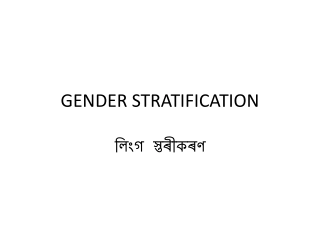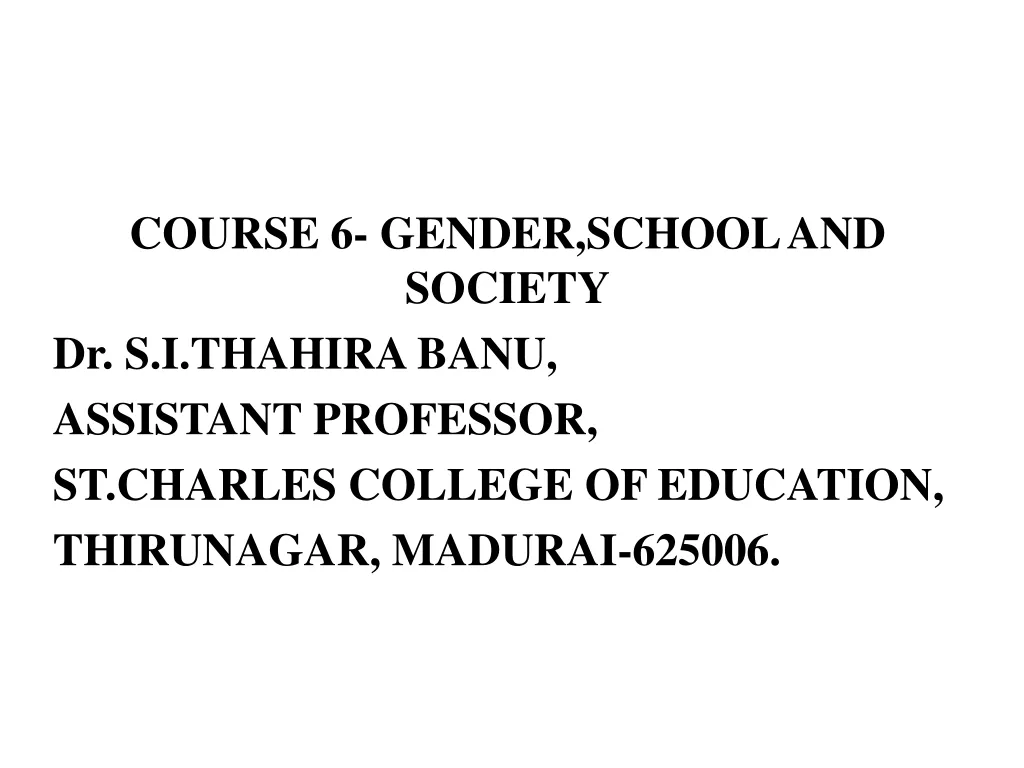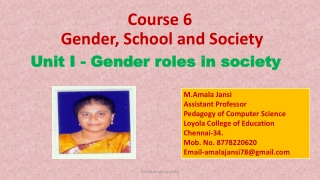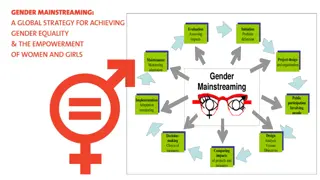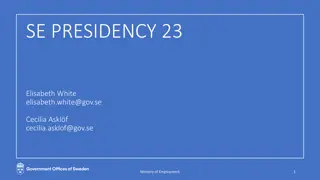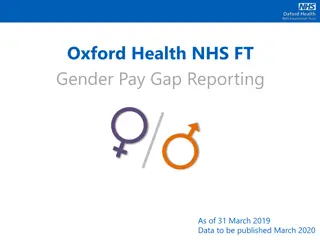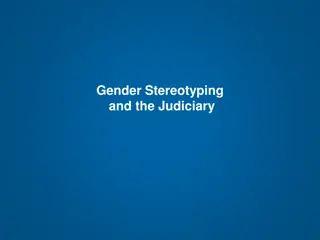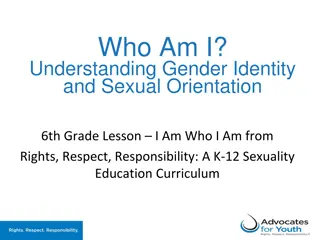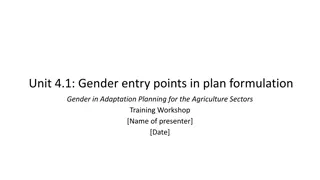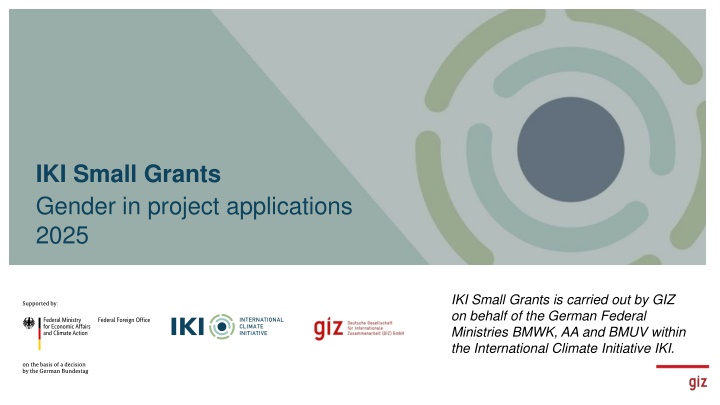
Gender Mainstreaming in Project Applications
Learn about the importance of considering gender in project applications, gender mainstreaming strategies, and the gender goals of the IKI Small Grants initiative. Discover how a gender-sensitive, gender-responsive, and gender-transformative approach can empower all genders and lead to more impactful project outcomes.
Download Presentation

Please find below an Image/Link to download the presentation.
The content on the website is provided AS IS for your information and personal use only. It may not be sold, licensed, or shared on other websites without obtaining consent from the author. If you encounter any issues during the download, it is possible that the publisher has removed the file from their server.
You are allowed to download the files provided on this website for personal or commercial use, subject to the condition that they are used lawfully. All files are the property of their respective owners.
The content on the website is provided AS IS for your information and personal use only. It may not be sold, licensed, or shared on other websites without obtaining consent from the author.
E N D
Presentation Transcript
IKI Small Grants Gender in project applications 2025 IKI Small Grants is carried out by GIZ on behalf of the German Federal Ministries BMWK, AA and BMUV within the International Climate Initiative IKI.
Why consider gender in your project? No project is gender-neutral! 1 Paying attention to gender roles and norms is required to prevent gender-based discrimination, disadvantages or violence in the project context. Reduces risk of negative impacts 2 Equal opportunities and equal participation for all social groups enhance the precision, ambition, quality, efficiency, and sustainability of project measures, thus making them more effective. Improves your results Page 2 IKI Small Grants Introduction Gender January 2025
What is gender mainstreaming? GENDER GENDER MAINSTREAMING is a strategic approach to reviewing and improving the impact of organisational actions on gender justice. Page 3 IKI Small Grants Introduction Gender January 2025
What is the gender goal of the IKI? IKI SMALL GRANTS PROJECTS GENDER NEGATIVE Unequal gender roles, relations and norms are upheld. GENDER BLIND Ignores unequal gender roles, relations and norms and gender-based discrimination. GENDER SENSITIVE Recognises unequal gender roles, relations and norms, but does not actively address them. GENDER RESPONSIVE Recognises unequal gender roles, relations and norms and attempts to actively combat them. GENDER TRANSFORMATIVE Addresses the deep roots of unequal gender roles, relations and norms. Please note: Gender responsive or transformative project proposals are highly encouraged and will be considered with priority. However, we are aware of the potential constraints and challenges you might be facing. Thus, we recommend to integrate the suggestions below wherever possible and openly communicate obstacles (e.g. data availability, lack of resources or expertise). Reflecting on limitations is not a disadvantage in the selection process. Page 4 IKI Small Grants Introduction Gender January 2025
REACH BENEFIT EMPOWER Approach Gender sensitive Gender responsive Gender transformative Design trainings that consider gendered needs, preferences & constraints to ensure that everyone benefits Strengthen abilities of all genders to make strategic life choices & put those choices into action Include women* in design of program activities Activities Enhancing women s decision making power in households/ communities/politics by challenging gender roles/ norms Women* make use of the learned skills, techniques, know how, etc. Invite women* as participants More equal decision-making power, e. g. in income use, agricultural production, reduction in time burden Indicators Number and proportion of participants successfully completing a training Sex-disaggregated data for indicators, e. g. increase of yields/income * By inclusion we mean that usually underrepresented groups participate as well. In many cases this will refer to women and gender minorities. However, targeting men as agents of change can be a powerful approach. True inclusion is intersectional (i. e. considers factors like age, social background, ethnicity, etc.). January 2025 IKI Small Grants Introduction Gender 5
How to integrate gender in your project proposal? Step 1: Analyse your context & target group Guiding questions What are gender differences in your project context in terms of roles and responsibilities, distribution of resources and representation, especially with respect to the problem you want to address? ? Consider the context in which the project will operate regarding gender-based discrimination and/or existing progress towards gender justice. Think intersectional! What are the characteristics of your target group and how do they affect their capacities to participate in project activities, e. g. care work, specific knowledge, special needs (accessibility of venues or training material for people with disabilities)? ? What is the risk of project activities inadvertently contributing to or continuing gender-based discrimination and how can these risks be minimised? What are potential synergies between contributions to gender justice and climate or biodiversity action and how can they be raised? ? ? Page 6 IKI Small Grants Introduction Gender January 2025
How to integrate gender in your project proposal? Step 2: Integrate your findings into your results logic & activities Based on your analysis, choose activities, outputs and (optionally) an outcome for your project that contribute to promoting gender justice and mitigating gender- based discrimination in your project context. Step 3: Make sure to include all expenses in the budget Additional costs for, among others, a gender analysis, a gender expert or collecting sex-disaggregated data are eligible cost that you should include in your budget. We also very much encourage equal pay! Page 7 IKI Small Grants Introduction Gender January 2025
Attributes of gender sensitive indicators 1 Disaggregated by sex Indicator findings are reported separately for men and women and gender minorities if applicable. This requires sex-disaggregated data collection. 2 Gender specific The indicator measures an initiative that is targeted at women, such as a women s cooperative. 3 Implicitly gendered The indicator addresses an issue which is of specific relevance to women and girls, such as safety of public transport. 4 Chosen by women rather than men The indicator is chosen by female community members/project staff and reflects the specific needs and priorities of women. Page 8 January 2025 IKI Small Grants Introduction Gender
You are not sure how to proceed? Meet us during our consultation hours We look forward to your questions! Time and date will be announced on the IKI Small Grants website. Make gender part of your capacity development concept We support your capacity development goals by funding among others: Training for staff members, development of a gender strategy for your organisation, a gender analysis for your proposed project, a consultant/expert to support implementation, monitoring, and evaluation Please note: The IKI Gender Strategy & Guidelines provide a good understanding of the topic, but they address large-scale IKI projects. The requirements are not mandatory for IKI Small Grants applicants. Check out further resources IKI Gender Strategy IKI Gender Guidelines With examples for each funding area in Annex I Gender responsive event management Page 9 IKI Small Grants Introduction Gender January 2025
IKI Small Grants Deutsche Gesellschaft f r Internationale Zusammenarbeit (GIZ) GmbH Potsdamer Platz 10 10785 Berlin iki-small-grants (at) giz.de IKI Small Grants is carried out by GIZ on behalf of the German Federal Ministries BMWK, AA and BMUV within the International Climate Initiative IKI.

